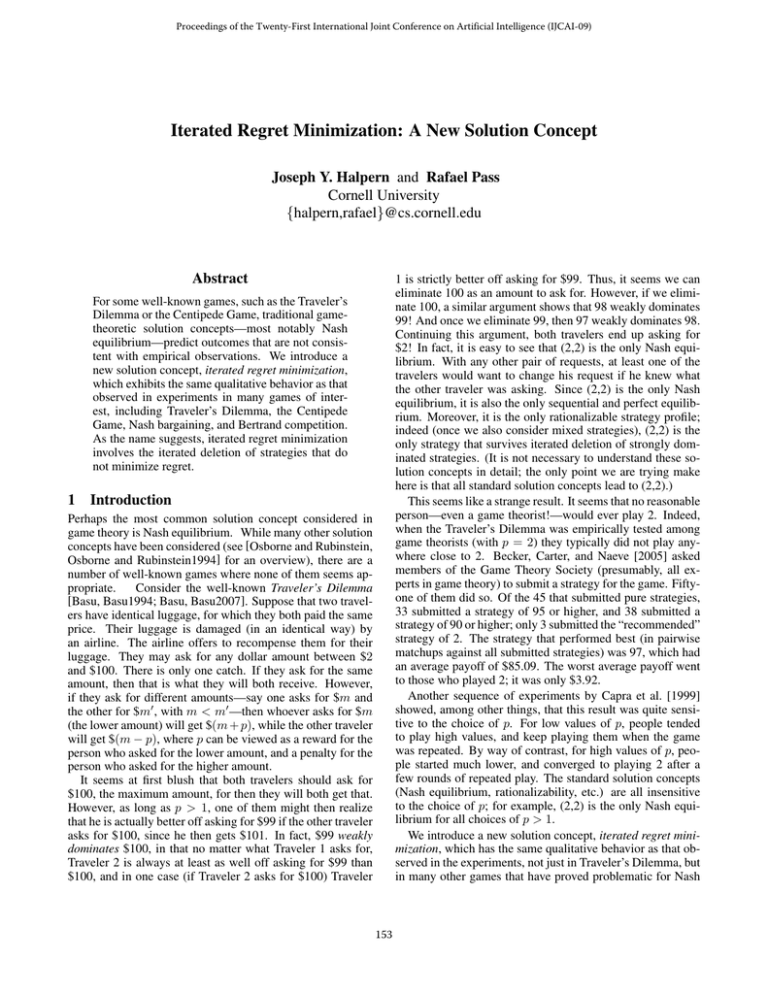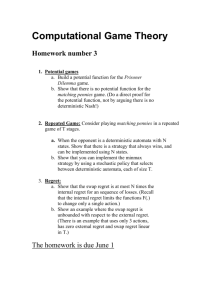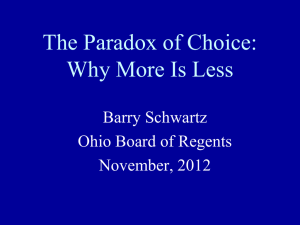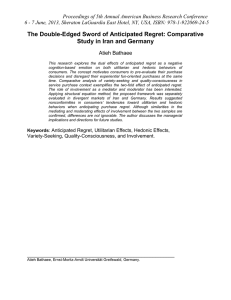Iterated Regret Minimization: A New Solution Concept Cornell University Abstract
advertisement

Proceedings of the Twenty-First International Joint Conference on Artificial Intelligence (IJCAI-09)
Iterated Regret Minimization: A New Solution Concept
Joseph Y. Halpern and Rafael Pass
Cornell University
{halpern,rafael}@cs.cornell.edu
Abstract
1 is strictly better off asking for $99. Thus, it seems we can
eliminate 100 as an amount to ask for. However, if we eliminate 100, a similar argument shows that 98 weakly dominates
99! And once we eliminate 99, then 97 weakly dominates 98.
Continuing this argument, both travelers end up asking for
$2! In fact, it is easy to see that (2,2) is the only Nash equilibrium. With any other pair of requests, at least one of the
travelers would want to change his request if he knew what
the other traveler was asking. Since (2,2) is the only Nash
equilibrium, it is also the only sequential and perfect equilibrium. Moreover, it is the only rationalizable strategy profile;
indeed (once we also consider mixed strategies), (2,2) is the
only strategy that survives iterated deletion of strongly dominated strategies. (It is not necessary to understand these solution concepts in detail; the only point we are trying make
here is that all standard solution concepts lead to (2,2).)
This seems like a strange result. It seems that no reasonable
person—even a game theorist!—would ever play 2. Indeed,
when the Traveler’s Dilemma was empirically tested among
game theorists (with p = 2) they typically did not play anywhere close to 2. Becker, Carter, and Naeve [2005] asked
members of the Game Theory Society (presumably, all experts in game theory) to submit a strategy for the game. Fiftyone of them did so. Of the 45 that submitted pure strategies,
33 submitted a strategy of 95 or higher, and 38 submitted a
strategy of 90 or higher; only 3 submitted the “recommended”
strategy of 2. The strategy that performed best (in pairwise
matchups against all submitted strategies) was 97, which had
an average payoff of $85.09. The worst average payoff went
to those who played 2; it was only $3.92.
Another sequence of experiments by Capra et al. [1999]
showed, among other things, that this result was quite sensitive to the choice of p. For low values of p, people tended
to play high values, and keep playing them when the game
was repeated. By way of contrast, for high values of p, people started much lower, and converged to playing 2 after a
few rounds of repeated play. The standard solution concepts
(Nash equilibrium, rationalizability, etc.) are all insensitive
to the choice of p; for example, (2,2) is the only Nash equilibrium for all choices of p > 1.
We introduce a new solution concept, iterated regret minimization, which has the same qualitative behavior as that observed in the experiments, not just in Traveler’s Dilemma, but
in many other games that have proved problematic for Nash
For some well-known games, such as the Traveler’s
Dilemma or the Centipede Game, traditional gametheoretic solution concepts—most notably Nash
equilibrium—predict outcomes that are not consistent with empirical observations. We introduce a
new solution concept, iterated regret minimization,
which exhibits the same qualitative behavior as that
observed in experiments in many games of interest, including Traveler’s Dilemma, the Centipede
Game, Nash bargaining, and Bertrand competition.
As the name suggests, iterated regret minimization
involves the iterated deletion of strategies that do
not minimize regret.
1
Introduction
Perhaps the most common solution concept considered in
game theory is Nash equilibrium. While many other solution
concepts have been considered (see [Osborne and Rubinstein,
Osborne and Rubinstein1994] for an overview), there are a
number of well-known games where none of them seems appropriate.
Consider the well-known Traveler’s Dilemma
[Basu, Basu1994; Basu, Basu2007]. Suppose that two travelers have identical luggage, for which they both paid the same
price. Their luggage is damaged (in an identical way) by
an airline. The airline offers to recompense them for their
luggage. They may ask for any dollar amount between $2
and $100. There is only one catch. If they ask for the same
amount, then that is what they will both receive. However,
if they ask for different amounts—say one asks for $m and
the other for $m , with m < m —then whoever asks for $m
(the lower amount) will get $(m + p), while the other traveler
will get $(m − p), where p can be viewed as a reward for the
person who asked for the lower amount, and a penalty for the
person who asked for the higher amount.
It seems at first blush that both travelers should ask for
$100, the maximum amount, for then they will both get that.
However, as long as p > 1, one of them might then realize
that he is actually better off asking for $99 if the other traveler
asks for $100, since he then gets $101. In fact, $99 weakly
dominates $100, in that no matter what Traveler 1 asks for,
Traveler 2 is always at least as well off asking for $99 than
$100, and in one case (if Traveler 2 asks for $100) Traveler
153
equilibrium, including the Centipede Game, Nash bargaining,
and Bertrand competition. We focus on iterated regret minimization in strategic games, and comment on how it can be
applied to Bayesian games.
2
then the acts that minimize regret are the ones in the interval
[100 − 2p, 100]; the regret for all these acts is 2p − 1. For if
player 1 asks for an amount m ∈ [100 − 2p, 100] and player 2
asks for an amount m ≤ m, then the payoff to player 1 is at
least m − p, compared to the payoff of m + p − 1 (or just m
if m = 2) that is achieved with the best response; thus, the
regret is at most 2p − 1 in this case. If, instead, player 2 asks
for m > m, then player 1 gets a payoff of m + p, and the
best possible payoff in the game is 99 + p, so his regret is at
most 99 − m ≤ 2p − 1. On the other hand, if player 1 chooses
m < 100 − 2p, then his regret will be 99 − m > 2p − 1 if
player 2 plays 100. On the other hand, if p ≥ 50, then the
unique act that minimizes regret is asking for $2.
Suppose that 2 ≤ p ≤ 49. Applying regret minimization
once suggests using a strategy in the interval [100 − 2p, 100].
But we can iterate this process. If we assume that both players
use a strategy in this interval, then the strategy that minimizes
regret is that of asking for $(100 − 2p + 1). A straightforward
check shows that this has regret 2p − 2; all other strategies
have regret 2p − 1. If p = 2, this approach singles out the
strategy of asking for $97, which was found to be the best
strategy by Becker, Carter, and Naeve [2005]. As p increases,
the act that survives this iterated deletion process goes down,
reaching 2 if p ≥ 50. This matches (qualitatively) the findings of Capra et al. [1999].1
Iterated Regret Minimization
We start by providing an informal discussion of iterated regret
minimization in strategic (normal-form) games, and applying it to the Traveler’s Dilemma; we then give a more formal
treatment.
Nash equilibrium implicitly assumes that the players know
what strategy the other players are using. (See [Aumann
and Brandenburger, Aumann and Brandenburger1995] for a
discussion of the knowledge required for Nash equilibrium.)
Such knowledge seems unreasonable, especially in one-shot
games. Regret minimization is one way of trying to capture
the intuition that a player wants to do well no matter what the
other players do.
The idea of minimizing regret was introduced (independently) in decision theory by Savage [1951] and Niehans
[1948]. To explain how we use it in a game-theoretic context, we first review how it works in a single-agent decision
problem. Suppose that an agent chooses an act from a set A
of acts. The agent is uncertain as to the true state of the world;
there is a set S of possible states. Associated with each state
s ∈ S and act a ∈ A is the utility u(a, s) of performing act a
if s is the true state of the world. For simplicity, we take S and
A to be finite here. The idea behind the minimax regret rule is
to hedge the agent’s bets, by doing reasonably well no matter
what the actual state is. For each state s, let u∗ (s) be the best
outcome in state s; that is, u∗ (s) = maxa∈A u(a, s). The regret of a in state s, denoted regret u (a, s), is u∗ (s) − u(a, s);
that is, the regret of a in s is the difference between the utility
of the best possible outcome in s and the utility of performing act a in s. Let regret u (a) = maxs∈S regret u (a, s). For
example, if regret u (a) = 2, then in each state s, the utility of
performing a in s is guaranteed to be within 2 of the utility
of any act the agent could choose, even if she knew that the
actual state was s. The minimax-regret decision rule orders
acts by their regret; the “best” act is the one that minimizes
regret. Intuitively, this rule is trying to minimize the regret
that an agent would feel if she discovered what the situation
actually was: the “I wish I had chosen a instead of a” feeling.
Despite having been used in decision making for over 50
years, up until recently, there was little work on applying
regret minimization in the context of game theory. We discuss related work in Section 4; here, we describe our own
approach. We start by explaining it in the context of the Traveler’s Dilemma and restrict our attention to pure strategies.
We take the acts for one player to be that player’s pure strategy choices and take the states to be the other player’s pure
strategy choices. Each act-state pair is then just a strategy
profile; the utility of the act-state pair for player i is just the
payoff to player i of the strategy profile. Intuitively, each
agent is uncertain about what the other agent will do, and
tries to choose an act that minimizes his regret, given that uncertainty.
It is easy to see that, if the penalty/reward 2 ≤ p ≤ 49,
2.1
Formal Definitions
Let G = ([n], A, u) be a strategic game. We define iterated
regret minimization in a way that makes it clear how it relates to other solution concepts based on iterated deletion. In
particular, in the full paper [Halpern and Pass, Halpern and
Pass2008], we relate it to rationalizability, and iterated deletion of weakly and strongly dominated strategies. A deletion
operator D maps sets S = S1 ×· · ·×Sn of strategy profiles in
G to sets of strategy profiles such that D(S) ⊆ S. We require
that D(S) = D1 (S) × · · · × Dn (S), where Di maps sets of
strategy profiles to strategies for player i. Intuitively, Di (S) is
the set of strategies for player i that survive deletion, starting
with S. Note that the set of strategies that survive deletion
may depend on the set that we start with. Iterated deletion
then amounts to applying the D operator repeatedly, starting
with an appropriate initial set S0 of strategies, where S0 is
typically either the set of pure strategy profiles (i.e., action
profiles) in G or the set of mixed strategy profiles in G.
Definition 2.1 Given a deletion operator D and an initial set
S0 of strategies, the set of strategy profiles that survive iterated deletion with respect to D and S0 is
D∞ (S0 ) = ∩k>0 Dk (S0 )
(where D1 (S) = D(S) and Dk+1 (S) = D(Dk (S)). Similarly, the set of strategy profiles for player i that survive
iterated deletion with respect to D and S0 is Di∞ (S0 ) =
∩k>0 Dik (S0 ), where Di1 = Di and Dik+i = Di ◦ Dk .
1
Capra et al. actually considered a slightly different game where
the minimum bid was p (rather than 2). If we instead consider this
game, we get an even closer qualitative match to their experimental
observations.
154
We can now define the deletion operator RM appropriate for regret minimization in strategic games (we deal with
Bayesian games in Section 3). Intuitively, RMi (S) consists of all the strategies in Si that minimize regret, given
that the other players are using a strategy in S−i . In more
detail, we proceed as follows. Suppose that G is a strategic game ([n], A, u) and that S ⊆ A, the set of pure strategy profiles (i.e., actions). For a−i ∈ S−i , let uSi i (a−i ) =
maxai ∈Si ui (ai , a−i ). Thus, uSi i (a−i ) is the best outcome
for i given that the remaining players play a−i and that i
can select actions only in Si . For ai ∈ Si and a−i ∈ S−i ,
let the regret of ai for player i given a−i relative to Si , denoted regret Si i (ai | a−i ), be uSi i (a−i ) − ui (ai , a−i ). Let
regret Si (ai ) = maxa−i ∈S−i regret Si (ai | a−i ) denote the
maximum regret of ai for player i (given that the other
players’ actions are chosen from S−i ). Let minregret Si =
S
minai ∈Si regret i −i (ai ) be the minimum regret for player i
relative to S. Finally, let
2.2
An Epistemic Characterization
Traditional solution concepts typically assume common
knowledge of rationality, or at least a high degree of mutual knowledge of rationality. (This point is discussed in
more detail in the full paper.) But if we make this assumption
(and identify rationality with minimizing regret), we seem to
run into a serious problem with Iterated Regret Minimization, which is well illustrated by the Traveler’s Dilemma. As
we observed earlier, the strategy profile (97, 97) is the only
one that survives iterated regret minimization when p = 2.
However, if agent 1 knows that player 2 is playing 97, then
he should play 96, not 97! That is, among all strategies, 97
is certainly not the strategy minimizes regret with respect to
{97}.
In the full paper, we give an epistemic characterization of
Iterated Regret Minimization that deals with this problem.
We sketch the main ideas here.
Some of these difficulties also arise when dealing with iterated deletion of weakly dominated strategies. The justification for deleting a weakly dominated strategy is the existence
of other strategies. But this justification may disappear in
later deletions. As Mas-Colell, Whinston, and Green [1995,
p. 240] put it:
RMi (S) = {ai ∈ Si : regret Si (ai ) = minregret Si }.
Thus, RMi (S) consists of the set of actions that achieve the
minimal regret with respect to S. Clearly RMi (S) ⊆ S. Let
RM(S) = RM1 (S) × · · · × RMn (S).
If S consists of mixed strategies, then the construction of
RM(S) is the same, except that the expected utility operator
Ui is used rather than ui in defining regret i .
[T]he argument for deletion of a weakly dominated
strategy for player i is that he contemplates the possibility that every strategy combination of his rivals
occurs with positive probability. However, this hypothesis clashes with the logic of iterated deletion,
which assumes, precisely, that eliminated strategies
are not expected to occur.
Definition 2.2 Let G = ([n], A, u) be a strategic game.
RM∞
i (A) is the set of (pure) strategies for player i that survive iterated regret minimization with respect to pure strategies in G. Similarly, RM∞
i (Σ(A)) is the set of (mixed)
strategies for player i that survive iterated regret minimization with respect to mixed strategies in G.
Brandenburger, Friedenburg, and Kiesler [2008] resolve
this paradox in the context of iterated deletion of weakly
dominated strategies by assuming that strategies were not
really eliminated. Rather, they assumed that strategies that
are weakly dominated occur with infinitesimal (but nonzero)
probability.
Unfortunately, this approach does not seem to help in the
context of iterated regret minimization. Assigning deleted
strategies infinitesimal probability will not make 97 a best
response to a set of strategies where 97 is given very high
probability. We deal with this problem by essentially reversing the approach taken by Brandenburger, Friedenberg, and
Keisler. Rather than assuming common knowledge of rationality, we assign successively lower probability to higher orders of rationality. The idea is that now, with overwhelming
probability, no assumptions are made about the other players; with probability , they are assumed to be rational, with
probability 2 , the other players are assumed to be rational
and to believe that they are playing rational players, and so
on. (Of course, “rationality” is interpreted here as minimizing
expected regret.) Thus, for example, in Traveler’s Dilemma,
players do not play 96 because they are still assuming that,
with overwhelming likelihood, the other player is playing an
arbitrary strategy (not 97); 97 is slightly better than the other
strategies that minimize regret given the slight likelihood that
the other player is minimizing regret. As we show in the full
paper, this approach does indeed justify iterated regret minimization.
The following theorem, proved in the full paper [Halpern
and Pass, Halpern and Pass2008], shows that iterated regret
minimization is a reasonable concept in that, for all games G,
RM∞ (A) and RM∞ (Σ(A)) are nonempty fixed points of
the deletion process, that is, RM(RM∞ (A)) = RM∞ (A)
and RM(RM∞ (Σ(A))) = RM∞ (Σ(A)); the deletion
process converges at RM∞ . (Our proof actually shows that
for any nonempty closed set S of strategies, the set RM∞ (S)
is nonempty and is a fixed point of the deletion process.)
Theorem 2.3 Let G = ([n], A, u) be a strategic game. If S is
a closed, nonempty set of strategies of the form S1 × . . . × Sn ,
then RM∞ (S) is nonempty, RM∞ (S) = RM∞
1 (S)×. . .×
∞
∞
RM∞
n (S), and RM(RM (S)) = RM (S).
Unlike solution concepts that implicitly assume that agents
know other agents’ strategies, in a strategy profile that survives iterated regret minimization, a player is not making a
best response to the strategies used by the other players since,
intuitively, he does not know what these strategies are. As a
result, a player chooses a strategy that ensures that he does
reasonably well compared to the best he could have done, no
matter what the other players do. We shall see the impact of
this in the examples of Section 2.3.
155
2.3
Examples
way of contrast, it is not hard to show that all pure strategies where player 1 quits at some point (including the one
where he continues until to his last move, and then quits)
are rationalizable. Thus, Nash equilibrium seems to eliminate too many strategies, while rationalizabilitiy eliminates
too few. In empirical tests (which have been done with linear payoffs), subjects usually cooperate for a certain number
of rounds, although it is rare for them to cooperate throughout the whole game [McKelvey and Palfrey, McKelvey and
Palfrey1992; Nagel and Tang, Nagel and Tang1998]. As
we show in the full paper, using iterated regret minimization,
with linear payoffs, we also get cooperation for a number of
rounds (which depends on the penalty); with exponential payoffs, we get cooperation up to the end of the game. Our results suggest some further experimental work, with regard to
the sensitivity of the game to the payoffs.
We now consider the outcome of iterated regret minimization
in a number of standard games, showing how it compares to
the strategies recommended by other solution concepts. Due
to lack of space, we focus here on just a few games and restrict to pure strategies; in the full paper, we consider a number of other examples, and also consider mixed strategies.
Example 2.4 Traveler’s Dilemma: If G = ([n], A, u) is
the Traveler’s Dilemma, then using the arguments sketched
2
in the introduction, we get that RM∞
i (A) = RMi (A) =
{100 − 2p + 1} if p ≥ 50. As we mentioned, (2, 2) is the only
action profile (and also the only mixed strategy profile) that
is rationalizable (resp., survives iterated deletion of weakly
dominated strategies, is a Nash equilibrium). Moreover, if
we allow an action to be deleted if it is strongly dominated by
a mixed strategy, then (2, 2) is the only action profile that survives iterated deletion of strongly dominated strategies. (This
is not surprising, since it is well known [Osborne and Rubinstein, Osborne and Rubinstein1994] that a strategy survives iterated deletion of strongly dominated strategies iff it
is rationalizable.) Thus, iterated regret minimization is quite
different from all these other approaches in the Traveler’s
Dilemma, and gives results that are in line with experimental observations.
Example 2.6 Coordination games: Suppose that A1 =
A2 = {a, b}, and u(a, a) = (k1 , k2 ), u(b, b) =
(1, 1), u(a, b) = u(b, a) = (0, 0), where k1 , k2 > 0. Both
(a, a) and (b, b) are Nash equilibria, but (a, a) Pareto dominates (b, b) if k1 , k2 > 1: both players are better off with
the equilibrium (a, a) than with (b, b). With regret minimization, we do not have to appeal to Pareto dominance if we
stick to pure strategies. It is easy to see that if k1 , k2 > 1,
∞
RM11 (A) = RM12 (A) = RM∞
1 (A) = RM2 (A) =
{a} (yielding regret 1). Similarly, if k1 , k2 < 1, then
∞
RM∞
1 (A) = RM2 (A) = {b}, and if if k1 = k2 = 1,
1
1
∞
RM1 (A) = RM2 (A) = RM∞
1 (A) = RM2 (A) =
{a, b}. Finally, if k1 > 1, and k2 < 1, then the unique profile
that minimizes regret is (a, b), which results in both players
getting a payoff of 0. While this is unfortunate, in the absence
of any coordinating device, this may well be the outcome that
is played between two players meeting for the first time.
Example 2.5 Centipede Game: Another well-known game
for which traditional solution concepts provide an answer that
is not consistent with empirical observations is the Centipede
Game [Rosenthal, Rosenthal1982]. In the Centipede Game,
two players play for a fixed number k of rounds (known at the
outset). They move in turn; the first player moves in all oddnumbered rounds, while the second player moves in evennumbered rounds. At her move, a player can either stop the
game, or continue playing (except at the very last step, when
a player can only stop the game). For all t, player 1 prefers
the stopping outcome in round 2t + 1 (when she moves) to
the stopping outcome in round 2t + 2; similarly, for all t,
player 2 prefers the outcome in round 2t (when he moves) to
the outcome in round 2t + 1. However, for all t, the outcome
in round t + 2 is better for both players than the outcome in
round t.
Consider two versions of the Centipede Game. The first
has exponential payoffs. In this case, the utility of stopping at
odd-numbered rounds t is (2t + 1, 2t−1 ), while the utility of
stopping at even-numbered rounds is (2t−1 , 2t + 1). Thus, if
player 1 stops at round 1, player 1 gets 3 and player 2 gets 1;
if player 2 stops at round 4, then player 1 gets 8 and player 2
gets 17; if player 2 stops at round 20, the both players get over
500,000. In the version with linear payoffs with punishment
p > 1, if t is odd, the payoff is (t, t − p), while if t is even,
the payoff is (t − p, t).
The game can be described as a strategic game where Ai is
the set of strategies for player i in the extensive-form game. It
is straightforward to show (by backwards induction) that the
only strategy profiles that survive iterated deletion of weakly
dominated strategies are ones where player 1 stops at the first
move and player 2 stops at the second move. Moreover, in
all Nash equilibria, the first player stops at the first move. By
3
Bayesian Games
Bayesian games are a well-known generalization of strategic
games, where each agent is assumed to have a characteristic
or some private information not known to the other players.
This is modeled by assuming each player has a type. Typically it is assumed that that there is a commonly known probability over the set of possible type profiles. Thus, a Bayesian
game is tuple ([n], A, u, T, π), where, as before, [n] is the set
of players, A is the set of action profiles, u is the profile of
utility functions, T = T1 × . . . × Tn is the set of type profiles
(where Ti represents the set of possible types for player i),
and π is a probability measure on T . A player’s utility can
depend, not just on the action profile, but on the type profile.
Thus, ui : A × T → IR. For simplicity, we assume that
Pr(ti ) > 0 for all types ti ∈ Ti and i = 1, . . . , n (where ti is
an abbreviation of {t : ti = ti }).
A strategy for player i in a Bayesian game in a function
from player i’s type to an action in Ai ; that is, what a player
does will in general depends on his type. For a pure strategy
profile σ , player i’s expected utility is
π(t)ui (σ1 (t1 ), . . . , σn (tn )).
Ui (σ ) =
t∈T
156
On the other hand, if v > v or v = v and j < i, then
i does not win the auction. He feels regret if he could have
won the auction and still paid at most v. To win, if j < i,
he must bid v + 1, in which case his regret is v − v − 1.
In this case, v can be as small as v , so his regret is at most
v − v − 1. If j > i, then he must only bid v to win, so his
regret is v − v , but v ≥ v + 1, so his regret is again at most
v − v − 1. It follows that bidding v = v/2 is the unique
action that minimizes regret (yielding a regret of v/2 − 1).
Player i’s expected utility with a mixed strategy profile σ is
computed by computing the expectation with respect to the
probability on pure strategy profiles induced by σ . Given
these definitions, a Nash equilibrium in a Bayesian game is
defined in the same way as a Nash equilibrium in a strategic
game.
There are some subtleties involved in doing iterated deletion in Bayesian games. Roughly speaking, we need to relativize all the previous definitions so that they take types into
account. We give the definitions for pure strategies; the modifications to deal with mixed strategies are straightforward and
left to the reader.
As before, suppose that S = S1 ×. . .×Sn . Moreover, suppose that, for each player i, Si is also a crossproduct; that is,
for each type t ∈ Ti , there exists a set of actions A(t) ⊆ Ai
such that Si consists of all strategies σ such that σ(t) ∈ A(t)
for all t ∈ Ti . For a−i ∈ S−i and t ∈ T , let uSi i (a−i , t) =
maxai ∈S ui (ai , a−i , t). For ai ∈ Si , a−i ∈ S−i , and t ∈ T ,
the regret of ai for player i given a−i and t, relative to Si ,
denoted regret Si i (ai | a−i , t), is uSi i (a−i , t) − ui (ai , a−i , t).
Let regret Si (ai | t) = maxa−i ∈S−i (t−i ) regret Si (ai | a−i , t)
denote the maximum regret of player i given t. The expected regret of ai given ti and S−i is E[regret Si i (ai | ti )] =
Si
Si
t∈T Pr(t | ti )regret i (ai | t). Let minregret (ti ) =
minai ∈Si (ti ) E[regret Si (ai | ti ). We delete all those strategies that do not give an action that minimizes expected
regret for each type. Thus, let RMi (Si ) = {σ ∈
Si : regret Si i (σ(ti ) | ti ) = minregret Si (ti )}, and define
RM(S) = RM1 (S1 ) × . . . × RMn (Sn ). We can then
apply iterated deletion to this deletion operator.
In the full paper, we use regret minimization to analyze
revenue-maximizing mechanisms for combinatorial auctions.
4
Related Work
While the notion of regret has been well studied in the context of decision theory (see [Hayashi, Hayashi2008] and the
references therein for some discussion of the recent work),
there has been surprisingly little work on applying regret to
game theory. Linhart and Radner [1989] applied regret to a
bargaining problem, and showed that it leads to solutions that
seem much more reasonable than Nash equilibrium. Hyafil
and Boutilier [2004] consider pre-Bayesian games, where
each agent has a type and a player’s utility depends on both
the action profile and the type profile, just as in a Bayesian
game, but now there is no probability on types.2 The solution concept they use is a hybrid of Nash equilibrium and
regret. Roughly speaking, they take regret with respect to the
types of the other players, but use Nash equilibrium with respect to the strategies of other players. That is, they define
regret Si i (ai | a−i , t) as we do (taking Si to consist of all
strategies for player i), but then define regret Si (ai | a−i ) by
minimizing over all t−i . They then define a profile σ to be a
minimax-regret equilibrium if, for all type profiles t, no agent
can decrease his regret by changing his action. For strategic
games, where there are no types (i.e., |T | = 1), their solution
concept collapses to Nash equilibrium. Thus, their definitions
differ from ours in that they take regret with respect to types,
not with respect to the strategies of other players as we do,
and they do not iterate the regret operation.
Even closer to our work is a recent paper by Renou and
Schlag [2008] (done independently of ours). Just as we do,
they focus on strategic games. Although they define regret
for pure strategies, this is only a tool for dealing with mixed
strategies; they do not consider the regret of a pure strategy
with respect to a set of pure strategies, as we do (and they do
not consider iteration). In particular, they have no analogue to
our analysis of pure strategies in Section 2.3. Moreover, their
definition of regret for mixed strategies is somewhat different
from ours; see the full paper for a detailed comparison.
Example 3.1 Second-Price Auction: A second-price auction
can be modeled as a Bayesian game, where a player’s type
is his valuation of the product being auctioned. His possible
actions are bids. The player with the highest bid wins the
auction, but pays only what the second-highest (For simplicity, we assume that in the event of a tie, the lower-numbered
player wins the auction.) If he bids b and has valuation (type)
v, his utility is v − b; if he does not win the auction, his utility
is 0. As is well known, in a second-price auction, the strategy
where each player bids his type is weakly dominant; hence,
this strategy survives iterated regret minimization. No other
strategy can give a higher payoff, no matter what the type
profile is.
Example 3.2 First-Price Auction: In a first-price auction,
the player with the highest bid wins the auction, but pays his
actual bid. Assume, for simplicity, that bids are natural numbers, that the lower-numbered player wins the auction in the
event of a tie, that all valuations are even, and that the product
is sold only if some player bids above 0. If a player’s valuation is v, then bidding v has regret max(v − 1, v − v − 1).
To see this, consider player i. Suppose that the highest bid of
the other agents is v , and that the highest-numbered agent
that bids v is agent j. If v < v or v = v and i < j, then
i wins the bid. He may have done better by bidding lower, but
the lowest he can bid and still win is 1, so his maximum regret
in this case is v − 1 (which occurs, for example, if v = 0).
5
Conclusion
There are many examples in the literature of games where
Nash equilibrium and its refinements do not describe what
2
Hyafil and Boutilier actually consider a slightly less general setting, where the utility for player i depends only on player i’s type,
not the whole type profile. Modifying their definitions for the more
general setting is straightforward.
157
people do. We have introduced a new solution concept, iterated regret minimization, that, at least in some games, seems
to capture better what people are doing than more standard
solution concepts. The outcomes of games like the Traveler’s
Dilemma and the Centipede Game have sometimes been explained by assuming that a certain fraction of agents will be
“altruistic”, and play the helpful action (e.g., playing 100 in
Traveler’s Dilemma or cooperating in the Centipede Game)
(cf., [Capra, Goeree, Gomez, and Holt, Capra et al.1999]).
Altruism may indeed be part of an accurate descriptive theory,
but to use it, we first need to decide what the “right” action
is, and also with what percentage agents are altruistic. We
also need to explain why this percentage may depend on the
degree of punishment (as it did in the experiments of Capra
et al. [1999], for example). Iterated regret minimization provides a different descriptive explanation, and has some normative import as well. It seems particularly appealing when
considering inexperienced but intelligent players that play a
game for the first time. In this setting, it seems unreasonable
to assume that players know what strategies other players are
using (as is implicitly assumed in Nash equilibrium).
uncertainty. In Proc. 20th Conf. Uncertainty in Artificial Intelligence (UAI 2004), pp. 268–277.
Linhart, P. B. and R. Radner (1989). Minimax-regret
strategies for bargaining over several variable. J. Economic Theory 48, 152–178.
Mas-Colell, A., M. Whinston, and J. Green (1995). Microeconomic Theory. Oxford University Press.
McKelvey, R. and T. Palfrey (1992). An experimental
study of the centipede game. Econometrica 60(4),
803–836.
Nagel, R. and F. F. Tang (1998). An experimental study on
the centipede game in normal form—An investigation
on learning. J. Mathematical Psychology 42, 239–265.
Niehans, J. (1948). Zur preisbildung bei ungewissen
erwartungen. Scbweizerische Zietschrift für Volkswirtschaft und Statistik 84(5), 433–456.
Osborne, M. J. and A. Rubinstein (1994). A Course in
Game Theory. MIT Press.
Renou, L. and K. H. Schlag (2008). Minimax regret and
strategic uncertainty. Working Paper No. 08/2, University of Leicester, Department of Economics.
Rosenthal, R. W. (1982). Games of perfect information,
predatory pricing, and the chain store paradox. J. Economic Theory 25, 92–100.
Savage, L. J. (1951). The theory of statistical decision.
J. American Statistical Association 46, 55–67.
Acknowledgements: We thank Geir Asheim, Sergei Izmalkov, Adam and Ehud Kalai, Silvio Micali, Ludovic Renou, Henry Schneider, and Kåre Vernby for helpful discussions. Halpern is supported in part by NSF under IIS0534064 and IIS-0812045, and AFOSR grant FA9550-08-10438. Pass is supported in part by an NSF CAREER Award
CCF-0746990, AFOSR grant FA9550-08-1-0197, and BSF
Grant 2006317.
References
Aumann, R. J. and A. Brandenburger (1995). Epistemic
conditions for Nash equilibrium. Econometrica 63(5),
1161–1180.
Basu, K. (1994). The traveler’s dilemma: paradoxes of
rationality in game theory. American Economic Review 84(2), 391–395.
Basu, K. (2007). The traveler’s dilemma. Scientific American June, 90–95.
Becker, T., M. Carter, and J. Naeve (2005). Experts
playing the Traveler’s Dilemma. Discussion paper
252/2005, Universität Hohenheim.
Brandenburger, A., A. Friedenberg, and J. Keisler (2008).
Admissibility in games. Econometrica 76(2), 307–
352.
Capra, M., J. K. Goeree, R. Gomez, and C. A. Holt (1999).
Anamolous behavior in a traveler’s dilemma. American Economic Review 89(3), 678–690.
Halpern, J. Y. and R. Pass (2008). Iterated regret
minimization: A more realistic solution concept.
arxiv.org/abs/0810.3023.
Hayashi, T. (2008). Regret aversion and opportunity dependence. J. Economic Theory 139(1), 242–268.
Hyafil, N. and C. Boutilier (2004). Regret minimizing
equilibria and mechanisms for games with strict type
158





